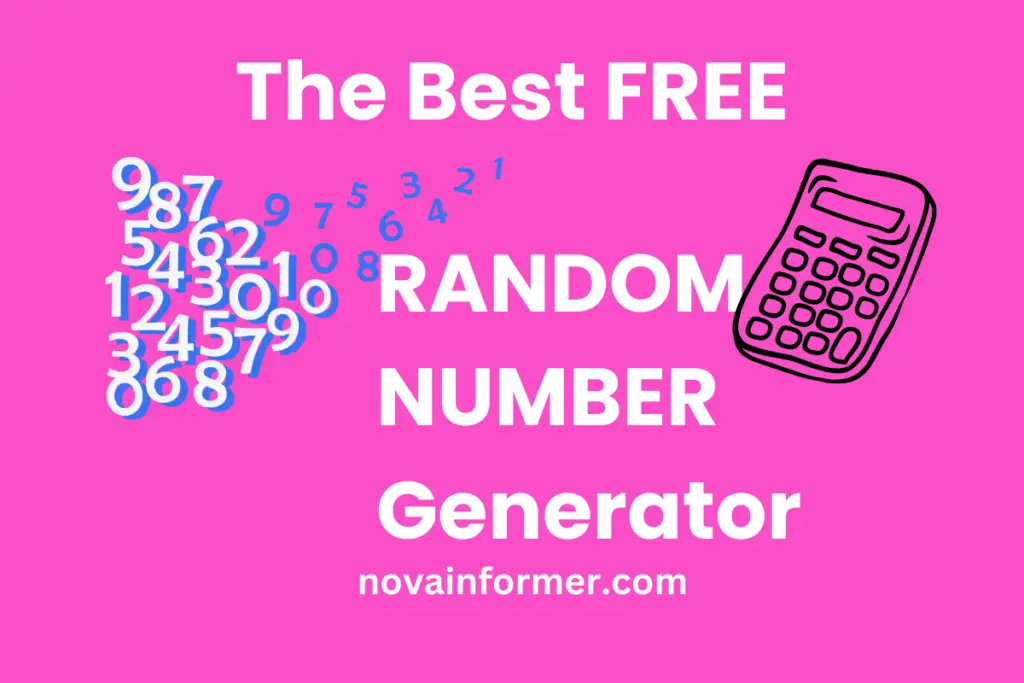Unlock fun and fairness with our free awesome Random Number Generator tool. Embrace randomness effortlessly.
Key Takeaways:
- Random Number Generators (RNGs) play a crucial role in various fields, from gaming to cryptography.
- There are two main types of RNGs: Pseudo-random and True random generators.
- RNGs operate on algorithms and mathematical models, with seed values influencing the generated randomness.
- Google incorporates RNGs in its search algorithms, affecting personalized search results.
Introduction
If randomness were a spice, Random Number Generators (RNGs) would be the master chefs in the digital kitchen, adding just the right amount of unpredictability to our online experiences. From shuffling cards in a virtual poker game to securing sensitive information through cryptographic processes, RNGs are the unsung heroes of the digital world. In this adventure, we’ll dive deep into the realms of RNGs, exploring their types, applications, and the magic behind their randomness.
Types of RNGs
Pseudo-Random vs. True Random: Decoding the Magic
When it comes to RNGs, it’s like choosing between a well-crafted illusion and pure cosmic randomness.
Pseudo-Random Number Generators (PRNG)
In the realm of PRNGs, algorithms dance to create sequences that mimic true randomness. Here’s a peek into the PRNG world:
| Algorithm | Period | Bias Possibility |
|---|---|---|
| Mersenne Twister | Long | Low |
| Linear Congruential | Limited | Moderate |
Key Insight: Mersenne Twister, with its long period, is a favorite in many applications.
True Random Number Generators (TRNG)
In the TRNG universe, randomness is sourced from the wonders of the physical world, like atmospheric noise or radioactive decay. Embracing the chaos, TRNGs stand tall:
| Source | Advantage | Limitation |
|---|---|---|
| Atmospheric Noise | True Unpredictability | Sensitivity to Environment |
| Radioactive Decay | Inherent Randomness | Limited Practicality |
Key Insight: TRNGs excel in scenarios where true unpredictability is non-negotiable.
Applications of RNGs
RNGs: Powering the Digital Symphony
RNGs are the maestros in various digital orchestras, orchestrating seamless experiences across diverse fields.
In the Gaming Realm
In the gaming arena, RNGs are the puppet masters behind fair play and unpredictable outcomes. Imagine a game without the element of surprise – it’s like a sandwich without the filling.
Key Insight: RNGs ensure each spin, shuffle, or draw is a surprise party for gamers.
In Cryptography
In the world of secrets and codes, RNGs are the guardians of cryptographic security. They create the unpredictable keys that lock and unlock the digital fortresses.
Key Insight: Without RNGs, cryptographic systems would be like a locked door with a predictable key.
In Simulations and Research
Scientists and researchers rely on RNGs to inject controlled randomness into simulations. It’s like having a digital dice that decides the fate of each simulated event.
Key Insight: RNGs enable controlled chaos, crucial for scientific exploration.
How RNGs Work
Unveiling the Magic Behind the Numbers
RNGs might seem like wizards casting spells of randomness, but their wand is a clever combination of algorithms and mathematical models.
The Role of Algorithms
RNGs follow specific algorithms that determine the sequence of numbers they generate. Each algorithm is like a secret recipe, producing a unique flavor of randomness.
Key Insight: The choice of algorithm impacts the quality and characteristics of randomness.
Seed Values: The Hidden Influence
Seed values act as the starting point for RNGs. Change the seed, and you change the entire sequence of numbers generated. It’s like starting a new game with different rules.
Key Insight: Seed values add an element of control to the apparent chaos of randomness.
Google’s Algorithm and Randomness
When Search Results Get a Dash of Randomness
Ever wondered why your search results sometimes surprise you? Well, that’s the RNGs in Google’s search algorithm, adding a sprinkle of randomness to tailor results just for you.
Personalized Search Results
Google employs RNGs to introduce variability in search results, ensuring a personalized experience for each user. It’s like having a virtual assistant who knows your preferences.
Key Insight: RNGs make your Google search journey a bit like a treasure hunt – you never know what gems you’ll find.
How to Use this Random Number Generator
Welcome to the world of randomness! Using this Random Number Generator is as easy as pie. Whether you’re planning a game night, need a random winner, or just want to add a sprinkle of unpredictability to your day, follow these simple steps:
Step 1: Set Your Range
Look for the “Min” and “Max” input boxes. These are your magic wands to control the range of your random number. Want a number between 1 and 100? Just enter 1 in the “Min” box and 100 in the “Max” box.
Step 2: Hit the Magic Button
Once you’ve set your desired range, it’s time for the magic moment. Locate the “Generate Number” button – it’s hard to miss with its inviting blue color. Give it a click, and voila! Your random number will appear like a digital fortune just for you.
Step 3: Enjoy the Randomness
Right there on the screen, you’ll see your freshly generated random number. It’s ready for action – whether you’re settling a bet, picking a movie, or deciding who gets the last slice of pizza.
Remember, the more you use it, the more you’ll appreciate the unpredictable charm of randomness. So go ahead, give it a whirl, and let the randomness unfold!
Pro Tip: If you ever mix up your Min and Max values, no worries! This smart tool will automatically swap them for you, ensuring the magic still happens.
That’s it! You’re now equipped to add a dash of randomness to your world. Happy generating! 🎉
In the next part, we’ll unravel the intricacies of different RNG types, delve into common algorithms, and explore the world of hardware RNGs. Get ready for a deeper dive into the captivating universe of Random Number Generators!
Pseudo-Random Number Generators (PRNG)
The Art and Science of Controlled Randomness
In the realm of Pseudo-Random Number Generators (PRNG), randomness is not truly random; it’s more like a well-rehearsed dance. Let’s explore the intricacies of PRNGs, the workhorses behind many digital applications.
Mersenne Twister: A Twisted Tale of Long Periods
Mersenne Twister stands tall among PRNGs, offering a long period before repeating sequences. It’s like a musical composition with numerous notes, ensuring a symphony of numbers.
Key Insight: Mersenne Twister’s long period minimizes predictability, making it a popular choice in diverse applications.
Linear Congruential: The Linear Ballet
Linear Congruential PRNGs are simpler but effective, creating sequences through a linear formula. It’s like a straightforward dance routine that still captivates the audience.
Key Insight: While limited in period, Linear Congruential PRNGs find their place in various applications with moderate randomness.
True Random Number Generators (TRNG)
Embracing the Chaos of True Randomness
True Random Number Generators (TRNG) take a different approach, harnessing the chaos of the physical world to generate truly unpredictable sequences.
Atmospheric Noise: Nature’s Random Symphony
TRNGs relying on atmospheric noise embrace the unpredictable whispers of nature. It’s akin to composing music using the sounds of the wind – ever-changing and impossible to predict.
Key Insight: While providing true unpredictability, atmospheric noise-based TRNGs can be sensitive to their environment.
Radioactive Decay: Harnessing Quantum Unpredictability
TRNGs tapping into radioactive decay utilize the inherently random nature of quantum processes. It’s like having a quantum dice that rolls in ways no one can predict.
Key Insight: Although inherently random, TRNGs based on radioactive decay have limited practicality due to safety concerns.
Common Algorithms Used in RNGs
Decoding the Digital Spells
RNGs operate on algorithms, each with its unique set of rules for conjuring randomness. Let’s peek behind the curtain and explore some common algorithms.
Middle Square Method: A Simple Shuffle
In the Middle Square Method, randomness is derived from squaring a number and selecting digits from the middle. It’s like shuffling a deck of cards with a quick sleight of hand.
Key Insight: While simple, the Middle Square Method has limitations and may exhibit patterns.
XOR-Shift: The Digital Bitwise Dance
XOR-Shift algorithms perform a digital dance of bitwise operations, creating sequences that seem random. It’s like a dance where each step is a carefully calculated move.
Key Insight: XOR-Shift strikes a balance between simplicity and randomness, often used in gaming applications.
Hardware RNGs
When Randomness Goes Physical
Hardware Random Number Generators (HRNG) bring an extra layer of security by tapping into the unpredictability of physical processes.
Quantum RNGs: Riding the Quantum Wave
Quantum RNGs leverage the principles of quantum mechanics, riding the waves of uncertainty. It’s like having a quantum magic eight ball that predicts the unpredictable.
Key Insight: Quantum RNGs hold the promise of unparalleled randomness, especially in the era of quantum computing.
Electronic Noise: The Unseen Chaotic Artist
HRNGs can also exploit electronic noise within circuits for randomness. It’s like finding art in the chaos of electronic whispers.
Key Insight: While less exotic than quantum methods, electronic noise-based HRNGs offer practical randomness for various applications.
Randomness Testing
Separating the Truly Random from the Pretenders
Ensuring the quality of randomness is crucial, and RNGs undergo various statistical tests to prove their worth.
Frequency Test: Counting the Beats
The Frequency Test checks if each number in the sequence appears with expected frequency. It’s like making sure every instrument in an orchestra plays its part.
Key Insight: Passing the Frequency Test indicates a balanced and unbiased RNG.
Poker Test: A Gamble with Randomness
Inspired by the game of poker, this test assesses the distribution of different poker hands. It’s like ensuring the deck is well-shuffled before the cards are dealt.
Key Insight: Passing the Poker Test indicates that the RNG produces diverse and unpredictable sequences.
Stay tuned for Part 3, where we’ll explore practical aspects, such as choosing the right RNG, implementing RNGs in programming, and addressing security concerns. Get ready for the final act in our journey through the captivating universe of Random Number Generators.
Choosing the Right RNG
Navigating the RNG Marketplace
Choosing the right Random Number Generator (RNG) is like picking the perfect tool for a specific job – it requires consideration of various factors.
- Application Specifics:
- Different RNGs suit different applications; consider the specific needs of your project.
- Gaming might require a balance of speed and unpredictability, while cryptographic applications demand utmost unpredictability.
- Quality of Randomness:
- Evaluate the results of randomness tests.
- Opt for RNGs that consistently pass these tests for unbiased and high-quality randomness.
- Period and Bias:
- Understand the period of the RNG – how long before it repeats its sequence.
- Consider the bias, ensuring the RNG doesn’t favor specific outcomes.
Implementing RNGs in Programming
Adding a Dash of Randomness to Code
Integrating RNGs into your code is like sprinkling a touch of magic – it brings unpredictability and excitement to your programs.
- Language-specific Approaches:
- Different programming languages may have specific libraries or functions for RNGs.
- Python, for example, offers the
randommodule for basic RNG needs.
- Seed Management:
- Carefully manage seed values to control the starting point of your RNG.
- Changing the seed should result in an entirely different sequence of numbers.
- Best Practices:
- Follow coding best practices to ensure randomness is utilized effectively and securely.
- Document the RNG implementation for future reference and collaboration.
Security Concerns and Best Practices
Securing the Dance of Numbers
In the realm of RNGs, security is paramount, especially in applications where unpredictability is a shield.
- Cryptographic Applications:
- Use RNGs specifically designed for cryptographic purposes.
- Regularly update cryptographic algorithms and protocols to stay ahead of potential vulnerabilities.
- Predictability Risks:
- Be aware of potential biases or patterns in certain RNGs.
- Regularly update and audit RNGs to mitigate emerging risks.
- Quantum Leap:
- Explore the potential of quantum RNGs for heightened security.
- Keep an eye on advancements in quantum computing and RNG technologies.
Future Trends in RNG Technology
Peeking into the RNG Crystal Ball
The future of Random Number Generators is as unpredictable as the numbers they generate. Let’s explore the emerging trends that might shape the RNG landscape.
- Quantum Leap:
- Quantum RNGs hold the promise of unprecedented randomness.
- Keep an eye on advancements in quantum technologies for practical implementations.
- Machine Learning Integration:
- Explore the intersection of machine learning and RNGs for enhanced predictive capabilities.
- Imagine RNGs evolving based on patterns identified by intelligent algorithms.
- Blockchain and RNGs:
- Investigate the synergy between blockchain technology and RNGs.
- Decentralized applications may increasingly rely on RNGs for fairness and transparency.
Frequently Asked Questions
What is the role of seed values in RNGs?
Seed values determine the starting point of RNG sequences. Changing the seed results in a different sequence, adding a layer of control to randomness.
How do hardware RNGs differ from software RNGs?
Hardware RNGs leverage physical processes (like quantum mechanics or electronic noise), providing true randomness. Software RNGs operate on algorithms, creating sequences that mimic randomness.
Are there any biases in pseudo-random number generators?
Yes, some PRNGs may exhibit biases or patterns. Choosing the right PRNG and regularly updating algorithms helps mitigate these risks.
Can RNGs be predicted or hacked?
While some PRNGs may have vulnerabilities, cryptographic RNGs and the unpredictability of TRNGs make prediction challenging. Regular security updates are essential.
What are the common statistical tests for evaluating RNGs?
Common tests include the Frequency Test, checking if each number appears with expected frequency, and the Poker Test, assessing the distribution of different poker hands.
How do you choose the right RNG for a specific application?
Consider factors like application specifics, quality of randomness, period, and bias. Evaluate RNGs based on their ability to pass randomness tests and meet the requirements of your project.
What are the language-specific approaches for implementing RNGs in programming?
Different programming languages may have specific libraries or functions for RNGs. For example, Python offers the random module for basic RNG needs.
What security concerns should be considered when using RNGs?
In cryptographic applications, use RNGs designed for security. Regularly update algorithms, be aware of biases, and explore emerging technologies like quantum RNGs for enhanced security.
In Conclusion
In the grand finale of our journey through the captivating universe of Random Number Generators, we’ve explored their types, delved into algorithms, and uncovered their applications in diverse fields.
From the calculated dance of Pseudo-Random Number Generators to the chaotic beauty of True Random Number Generators, these digital maestros add a touch of unpredictability to our digital experiences.
As we navigate the ever-expanding landscape of RNG technology, the future holds promises of quantum leaps, machine learning collaborations, and blockchain synergies.
So, whether you’re a gamer seeking the thrill of randomness or a security enthusiast safeguarding digital fortresses, RNGs continue to be the unsung heroes orchestrating the symphony of unpredictability in our digital world.
Stay curious, stay random, and embrace the magic of numbers!
License:
by Daniel Hearn (https://codepen.io/danhearn/pen/xdgmVO)



